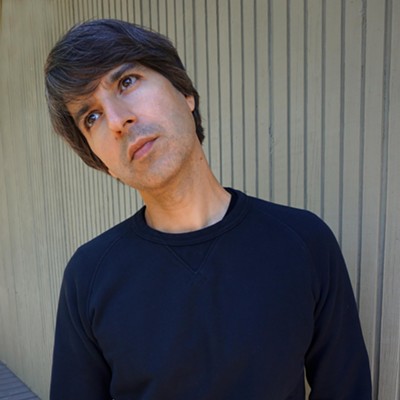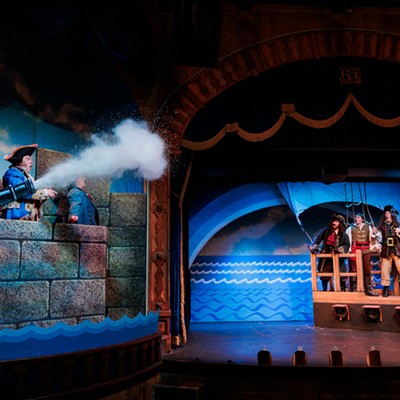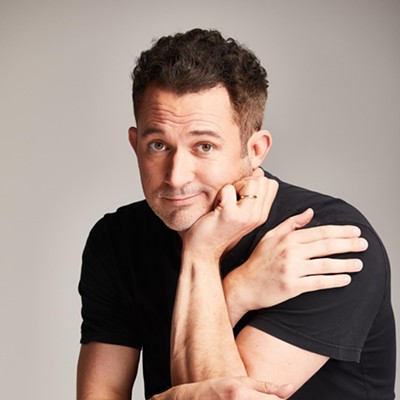Well, not vats, exactly: They're restaurant steam tables, the tidy metal containers that keep food hot at buffets. If they can keep creamed spinach warm, they can also turn out to be just the thing to heat up an artist's beeswax. In one, Conrad keeps his unrefined wax, colored a deep amber ("I get it from a grower in Southeast Texas"), and in the other, his pale yellow refined wax ("from an art supplier in Seattle.")
Wax art--called encaustic--"predates modern oil paint," says the 30-something Conrad, artily attired in a black shirt and black eyeglasses, and artily endowed with black hair. "People used ground-up pigment in wax in ancient Greece and Egypt. The Egyptians used it on their mummy casings and tomb murals."
Conrad gives the medium a modern twist by mixing oil paint into the molten wax, then painting colored abstractions on wooden boards. In the gallery out front, you can see his small meditative encaustics, as deep and densely colored as medieval religious paintings. His trio "Orange Series" runs the color gamut from earth brown to pale ochre, with just a hint of screaming orange spicing up the waxy 3-D circles, rectangles and stripes.
Sometimes, Conrad lets the wax harden on wire frames, and turns the squares into giant honeycombs, as he did last spring with Hive: Light, Space and Industry. That collaboration with sculptor Corbin Frame was the bees' knees of installations, an enormous, waxy beehive that filled a whole room in the Shane House Gallery downtown. If you missed it, you can see a whole wall of it standing in Conrad's new gallery; it's a crazy quilt of waxy squares in every shade of honey.
You can also come on down and see how Conrad works his waxy magic. He'll exhibit ultra-contemporary work by assorted artists in the gallery out front and invite people into his studio out back. Conrad Wilde Gallery is located at 210 N. Fourth Ave., and the gallery is open 11 a.m. to 6 p.m. Tuesday through Saturday. Call 622-8997 for more information.
"I'll do tours and demonstrations by appointment," he says enthusiastically. "I like to do it. It helps me develop relationships with people in the community."
The artist arrived from Seattle a year-and-a-half ago, attracted by the arts community in Tucson and a lower cost of living. He'd been looking to rent a studio, but then began to think of having a space where the public could come in and see his work. And once he considered having art lovers traipse through his studio, he thought, why not open a gallery as well?
"From a business perspective, it makes sense for me to represent my own work," he says. "And there are other artists I know who are emerging, or they may not have contacts or confidence. And other more established artists who have a place to show in Tucson. The vision kept getting larger."
When Dinnerware Contemporary Arts absconded from Fourth Avenue for the Warehouse District this summer, they left behind an empty gallery in good shape, and Conrad pounced. "I was very fortunate."
He installed new track lights, painted the walls sleek white and the ceiling warm black, and opened for business Sept. 3. The exhibitions will change monthly, with one-person shows in the main gallery and a mix of gallery artists in the smaller "salon." The first show, up through Wednesday, Sept. 28, exhibits Portland artist Katie Holly, a sculptor-turned-painter whose working style is at least as complicated as Conrad's. Holly pours wet cement on board, shapes it with a trowel, then paints and sands the dry surface. She finishes the whole thing with a wax-based glaze that gives the pieces a ceramic look.
"The gallery will have an emphasis on abstraction and innovative production techniques," Conrad says. "If I ran across representational work I liked, I wouldn't necessarily turn it away. I wouldn't be so rigid. But the point is, what could I offer Tucson that Tucson doesn't already have?"
Conrad is well aware of the jinx on fledgling Tucson galleries. Jason and Melba Falk gave him plenty of help, he says, but this summer abruptly closed their Falk Gallery, a few doors up Fourth Avenue.
"That was a big loss for Tucson," he says. "But now there's a new generation of contemporary galleries opening up--FALA and Platform (at Sixth Street and Sixth Avenue). I tried not to have too many expectations, but I was thrilled with the first opening. I got a lot of feedback and enthusiasm."
And just lately, he's noticed a "shift in the temperature." The cooler weather might bring out the art crowds, he reasons. Anyway, he adds, "I can't think of something else I'd rather be doing."











